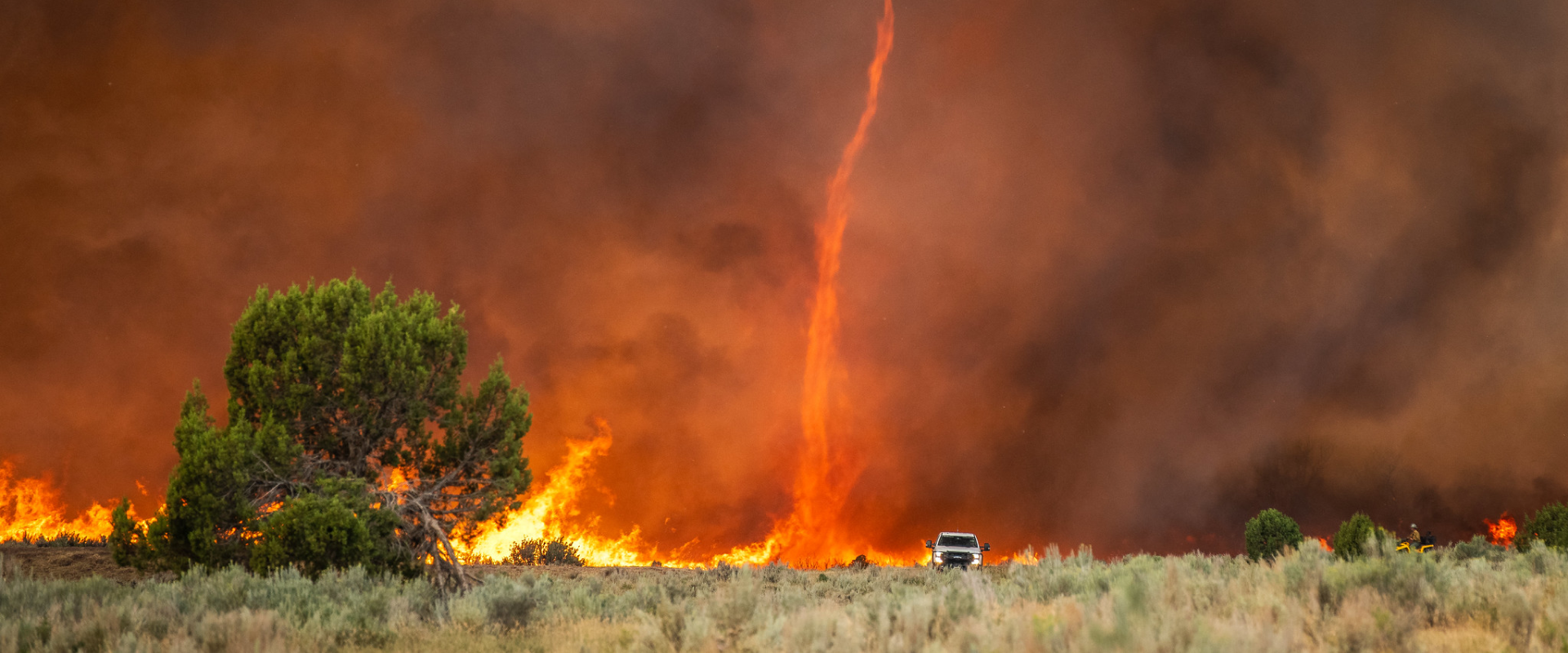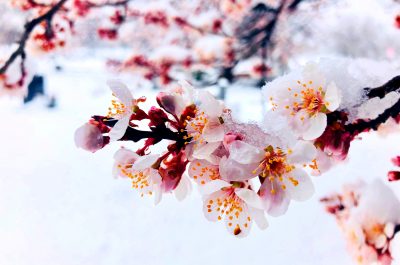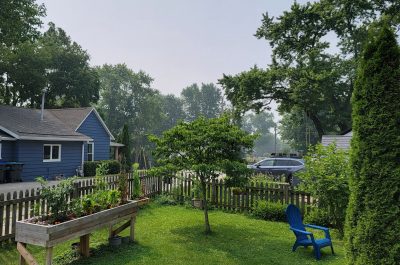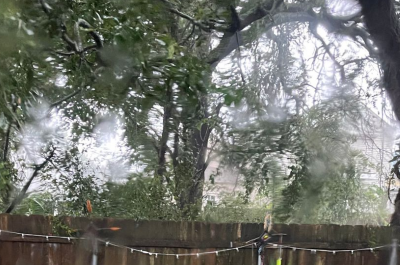As ISeeChangers across the world observed, 2020 was a record-breaking weather year on top of a world-wide public health crisis. On a global scale, it was one of the two hottest years on record. With the heat came the most active Atlantic hurricane season, and devastating, record-setting wildfires in Australia, South America, the Arctic and the U.S.
Hidden in those broken records are all of the lives impacted by disaster and more subtle symptoms of climate change. Thanks to the ISeeChange community, we saw in detail what these changes looked and felt like.
Here are ten climate trends that ISeeChangers saw in 2020:
1. First signs of a warming world appear in winter
The hot year started in the cold months with ISeeChangers in the U.S., Canada, the UK, and in Germany reporting unusually warm temperatures.
Things the winter is supposed to be devoid of — like allergies and mosquitoes — were turning up. In Judy Donnelly’s greenhouse in Windham, Connecticut, it got so warm in her greenhouse in early January that her lettuce began to wilt.
Across New England, the first months of 2020 were lacking snow and ice and often feeling like another season altogether. “It’s decidedly springlike – 62 degrees at 10 AM in the middle of January in Massachusetts. Birds chirping away like it’s March,” David Sittenfeld in Cambridge, Massachusetts wrote.
In Illinois, Mollyann Hesser, spotted signs of active beavers in January and open water where she’d usually expect ice.
2. A belated snow season brought spring snowstorms
For some, a warm winter was followed by a snowy spring. Some parts of the Northeastern U.S. got most of their snow in March.
It’s snowing here on this day in late March, probably more any other day through the entire winter.
In one part of Colorado, heavy snow fell after trees had begun budding out, leading to fears of broken branches and other crop and agricultural damage. A Nebraska-based ISeeChanger reported snow falling just as their tulips had begun to bloom.
— PJ Lela
3. Warmer winters cause signs of spring to pop up in January
The transition to spring began very early in the year for many ISeeChangers.
In Oak Island, North Carolina, Roseanne Fortner’s crocuses first bloomed on January 16, the earliest she’d ever noticed. “In other years, Crocuses have bloomed on Feb 4 [2019], Feb 26 [2018], and January 25 [2017],” she wrote.
Early blooms were reported by ISeeChangers across the U.S. in Florida, Louisiana, South Carolina, Michigan, Pennsylvania, Maryland, Massachusetts, Connecticut, Oklahoma, and Colorado.
Plants also budded out early in Sofia, Bulgaria.
It wasn’t just plants showing up early. For ISeeChangers in southern Louisiana the early spring brought mosquitoes. And swans arrived over a month early in the mitten-thumb of Michigan and worried Penny Barrons. “It’s going to be real cold — no food for them,” she wrote.
4. Warmer oceans lead to more severe hurricane seasons
Hurricane season also started early in 2020 with the first named storm in the Atlantic basin forming in mid-May.
— Chris S
In July, two named storms — Fay and Isaiahs — caused problems in the Northeastern U.S including flooding in Ocean City, New Jersey and power outages throughout the region.
New Orleans was in the forecast cone of seven named storms throughout the season.
Only one storm passed directly over the city, Hurricane Zeta on October 28. Zeta was a quick moving storm that didn’t cause street flooding, but it did cause many trees to fall across the city and extensive power outages.
Miami, where ISeeChange has an active partnership with the City to track flooding, was also unscathed by tropical storms until late in the season. The city, and people across south Florida, felt the impacts of Tropical Storm Eta the weekend of November 7 with many areas experiencing significant flooding.
5. Rainstorms are getting more intense and causing more flooding
In addition to more severe hurricane seasons, non-tropical heavy rainstorms are becoming more common and more intense. Throughout 2020, ISeeChangers documented both street flooding and river flooding from intense rainstorms.
Rain and impervious surfaces increase urban flooding
New Orleans often floods during intense rain. ISeeChangers in the area documented significant street flooding during four different rain events: February 26, May 15, July 10, and July 15. Community observations posted on ISeeChange were used to expand a forthcoming stormwater project.
Floating Red Ants and 18 inches of water at corner of Foy and Buchanan
From the success of their rain gardens, to parking cars on sand bags, NOLA ISeeChangers documented their innovation in dealing with the flooding challenges they face.
How to elevate your car cheaply without even needing to move it:
Standard sandbags can support the weight on a small car. I put one under each of the two front wheels and then drive on top of them. The extra two inches of elevation can make a big difference in street flooding!
I have never seen this anywhere else but I think it should become more common. This is about as much elevation as you get from parking on a neutral ground.
Sandbags: portable neutral grounds
ISeeChangers in Ocean City, New Jersey also experienced quite a bit of flooding from rain in 2020. Community members reported a dozen flood events from rainfall. (Addition flooding was caused or compounded by high tides, and that will be addressed further down this list.)
Once Ocean City resident, Rosanne Monfardini, who had been documenting the success of a flood remediation project in her area, found the spot flooding like it hadn’t since before the infrastructure changes.
Rain also raises river and lake levels
Intense rain also led to flooding along rivers, lakes and other bodies of water.
ISeeChanger Deanna Bell in O’Fallon, Illinois reported high river levels in January and June.
In North Carolina, a February storm caused creeks to rise quickly and flash flooding to occur.
“Two-lane Highway with standing puddles in the road means no visibility when a truck passes by you,” Max Cawley wrote. “How do we adapt rural infrastructure for heavier precipitation and more flooding?”
6. Sea level rise is causing more frequent high tide flooding
ISeeChangers in coastal communities in the Eastern U.S. reported flooding from high tides throughout the year and particularly during the fall king tides.
Tidal flooding was the worst when it occurred in sync with high winds or rain, but occurred on sunny days too.
Increasingly high tides, and the sea level rise fueling them, also cause erosion in coastal areas. ISeeChangers in Massachusetts and Australia documented eroding shorelines.
Hige storm surges, and never before see beach erosion. Houses at risk of falling into the sea.
In Delray Beach, Florida, Devin Borg worried about new buildings being built near the coast. “This is how we live with water. Pumping it out so we can move in & continue to build in the Southeast Florida region,” she wrote.
7. Extreme heat days and extended heatwaves becoming more frequent
Heatwaves were a global experience in 2020 for ISeeChangers from the U.S. to Germany to Israel. On ISeeChange, observations of extreme heat began in March with record-breaking days in New Orleans and the hottest March on record in Pensacola, Florida.
Throughout the hot summer months, outdoor exercise often presented challenges. One July evening in Virginia, Aidan Lilienfeld waited until after the sun went down to go for a run, but still overheated.
To cope with the heat, some stayed inside in the air conditioning. In other places, air conditioning is uncommon or expensive and inaccessible.
Many ISeeChangers found relief on hot days in the shade or in pools and at beaches.
Marcy Dubois in New Orleans documented how the poor state of her apartment complex keeps residents from being able to escape the heat. “The AC shuts down. Called on a Wednesday about it, no one came til almost a week later because they have ‘10+ AC units not working,’” she wrote. “The 4-6 pools they have are often covered in scum.”
In New Orleans, ISeeChangers used stationary sensors and teamed up with CAPA Strategies to collect data about urban heat in the city.
The extreme heat wasn’t confined to just life on land. Some lakes, rivers, and bays got so hot that fish couldn’t cope. Fish kills were recorded by ISeeChangers in Florida, Massachusetts and Ohio.
#YouKnowClimateChangeIsReal when we have to pump oxygen into the water!!
8. Dry winters and hot springs and summers fuel dangerous wildfires in the Western U.S.
While parts of the Southeast, like North Carolina, experienced one of their wettest years in history, the opposite was true across the country. ISeeChangers in the Western U.S. began noticing concerning signs of a drought year in the winter months. Snowpack was low in Grand Mesa, Colorado, and in El Cerrito, California, Lauren McNulty reported unusually little rain. “Peaceful sunset, but the good weather is deceiving,” she wrote of the missing rain.
The difference of one year in snow base on Grand Mesa (10,500 feet) in western Colorado.
After the poor winter precipitation McNulty documented, spring was very hot in Northern California, leading to worries about what the wildfire season would be like. Similar worries existed in Colorado where warming winters and drought have left large swaths of forest vulnerable to pest damage creating plenty of fire fuel.
The first major wildfires of the year posted on ISeeChange occurred in Arizona in June. By mid-July Amber Kleinman in Paonia, Colorado was going on three weeks of red flag fire weather warnings.
In August, a series of lightning storms in California’s Bay Area ignited the dry land and spread into some of the largest wildfires in history. Wildfires continued to light and scar Northern California, Oregon and Washington through September. Colorado also saw some of their largest wildfires in history in 2020 as well.
Smoke from the fires dimmed skies as far as Boston and made breathing, even indoors, difficult throughout the West.
— Viv Byrd
9. Drought-stricken New England struggled to manage plants through the hot summer
Across the country, the Northeast was also dealing with drought in the late summer and into fall.
In June, Judy Donnelly in Connecticut wrote, “We only had about 1/4 inch of rain in the past two weeks and there’s none in the forecast. The garden needs daily watering, even the parts under thick mulch. I hope the whole summer isn’t like this.”
Despite her hopes, the dryness continued and developed into moderate drought. It was a hard year on crops, gardens and trees. Ken Haradon in Mansfield, Massachusetts noted that some trees began dropping their leaves in mid-August as they tried to cope with the lack of water.
The drought even caused some sporadic blooming of spring plants like crabapples later in the fall.
10. COVID-19 showed how connected our health is to our environment
Like everything in 2020, the way that people interacted with and understood their environment was shaped by the COVID-19 pandemic.
As lockdowns began in early spring, ISeeChangers sought relief in the outdoors by exploring parks, doing home math class in sidewalk chalk, and appreciating the joy of small things like crocuses blooming. Songbirds seemed louder without traffic to interrupt, and the air was clearer in some places than ever previously remembered.
In Durham, North Carolina, Max Cawley noticed that without the regularly scheduled weed mowing in public spaces, plants were flowering and offering up more food to pollinators.
Nearby, Pam Dickens in Hillsborough, North Carolina, took up painting in her garden.
In Australia, Therese Ralston, found inspiration in a pair of thrushes that nested near her garage.
Due to three years of drought, the the worst bushfires in modern history and subsequent local flooding, everything is lush and green like it is in spring. So, mid-autumn in a few days and there are birds nesting, butterflies and caterpillars everywhere in this crazy second spring.
I don’t know if the Thrush chicks will survive April’s cooler weather, six months on from the first brood and at the wrong time of the year. But, somehow I hope they will grow up and fly away to come back and annoy me singing at 6 am with a melodious tune in the pre-dawn.
The environment is changing. Birds, animals, insects and reptiles are confused and think it is spring because it’s green once again. Even the trees are still wearing their bright green leaves, instead of losing them. I have hay-fever from clouds of grass seeds. The temperature is still a balmy 30 degrees and all my windows are still wide open all day.
I’ve been self-isolating on my farm for two weeks. My view is the view in the garage, of a pair mated for life doing their best to bring new life into the world while they can. And if you think being holed up in an apartment is confining, try sitting on a small nest for three weeks straight.
https://medium.com/@thereser/nesting-d6f73b9c8791?source=friends_link&sk=f1a652c7f31aca2e4f30fd1050b4ae58
Or, to see more of the birds I love, check out my blog:
http://birdlifesaving.com
We hope the new year finds you healthy and happy. Keep documenting change in your environment this winter and throughout 2021 on ISeeChange.
Cover photo by Eric Coulter for the National Interagency Fire Center.




